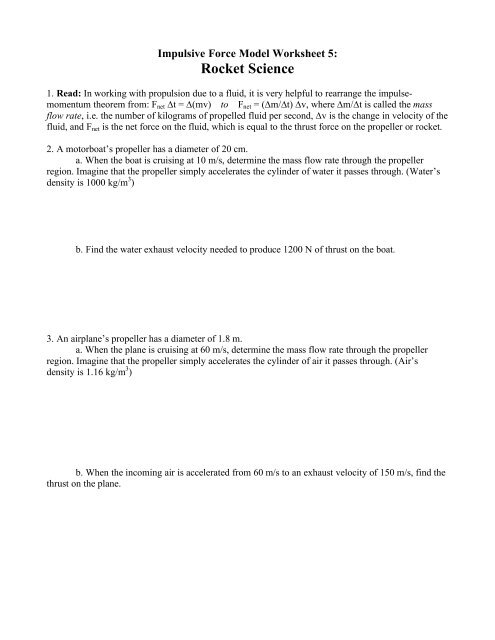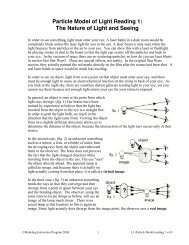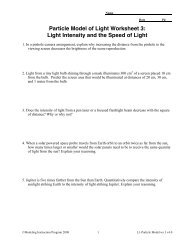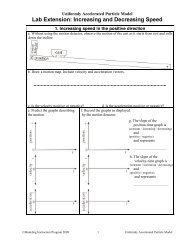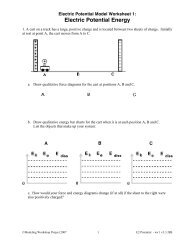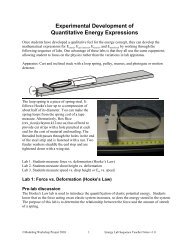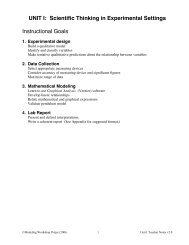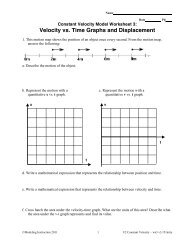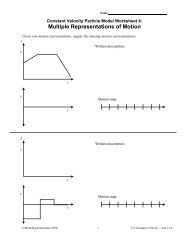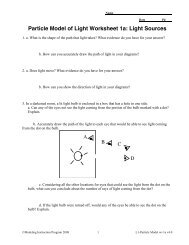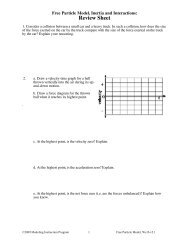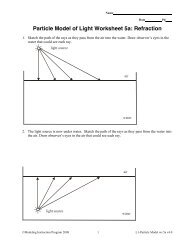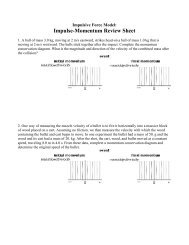Worksheet 5: Rocket Science - Modeling Physics
Worksheet 5: Rocket Science - Modeling Physics
Worksheet 5: Rocket Science - Modeling Physics
Create successful ePaper yourself
Turn your PDF publications into a flip-book with our unique Google optimized e-Paper software.
Impulsive Force Model <strong>Worksheet</strong> 5:<br />
<strong>Rocket</strong> <strong>Science</strong><br />
1. Read: In working with propulsion due to a fluid, it is very helpful to rearrange the impulsemomentum<br />
theorem from: F net ∆t = ∆(mv) to F net = (∆m/∆t) ∆v, where ∆m/∆t is called the mass<br />
flow rate, i.e. the number of kilograms of propelled fluid per second, ∆v is the change in velocity of the<br />
fluid, and F net is the net force on the fluid, which is equal to the thrust force on the propeller or rocket.<br />
2. A motorboat’s propeller has a diameter of 20 cm.<br />
a. When the boat is cruising at 10 m/s, determine the mass flow rate through the propeller<br />
region. Imagine that the propeller simply accelerates the cylinder of water it passes through. (Water’s<br />
density is 1000 kg/m 3 )<br />
b. Find the water exhaust velocity needed to produce 1200 N of thrust on the boat.<br />
3. An airplane’s propeller has a diameter of 1.8 m.<br />
a. When the plane is cruising at 60 m/s, determine the mass flow rate through the propeller<br />
region. Imagine that the propeller simply accelerates the cylinder of air it passes through. (Air’s<br />
density is 1.16 kg/m 3 )<br />
b. When the incoming air is accelerated from 60 m/s to an exhaust velocity of 150 m/s, find the<br />
thrust on the plane.
4. The space shuttle’s main engines spray out 736,000 kg of water vapor at 4500 m/s by chemically<br />
combining hydrogen and oxygen for 460 seconds. Find the average thrust force provided by the main<br />
engines.<br />
5. A 0.36 kg soda bottle rocket holds 1.5 kg of water as it sits upon the launch pad. The rocket expels<br />
all of the water in 0.7 seconds producing a rocket burnout velocity of 33 m/s. (The burnout velocity is<br />
the rocket’s velocity once thrust ceases.)<br />
a. Draw a force diagram for the 0.7 s thrust phase of the launch.<br />
b. Determine the mass flow rate for the rocket.<br />
c. Determine the rocket’s average acceleration for the 0.7 s thrust phase of the launch. When is<br />
the instantaneous acceleration of the rocket the greatest and the least<br />
d. Determine the average net force on the rocket.<br />
e. Determine the exhaust velocity of the water ejected from the rocket.


